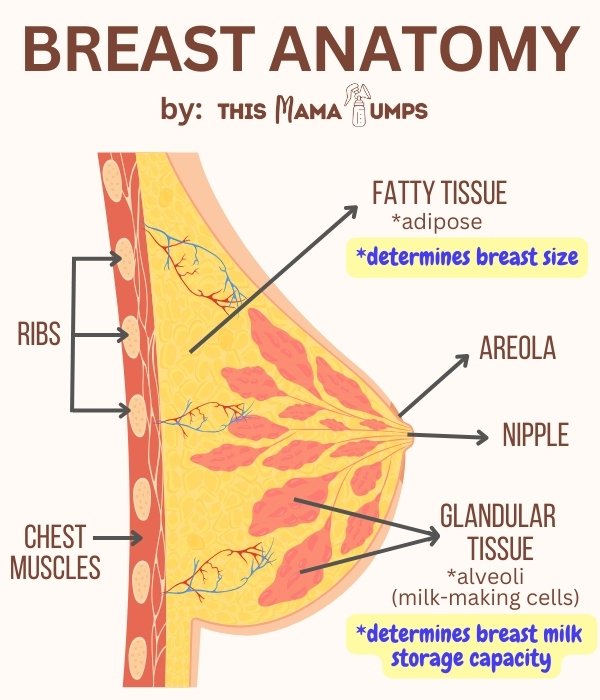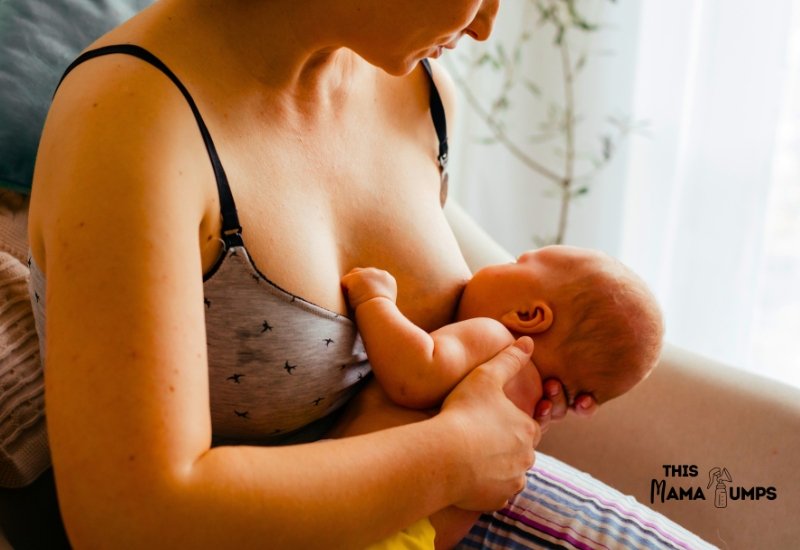I remember the first time a friend looked at my chest and said, ‘Wow, you’re going to have so much milk!‘
After giving birth, my baby’s pediatrician touched my boobs and told me “you have a lot of milk in there”.
As a new mom with D-cup breasts, I believed them.
I was sure I’d be a milk-making machine.
But when my baby struggled to latch and my supply seemed low, I realized something wasn’t right.
The truth is, breast size has nothing to do with your ability to breastfeed.
It’s a pervasive myth, but it’s simply not true.
Does breast size matter in breastfeeding?
Let’s get right to it:
Your breast SIZE does NOT predict milk supply. [1]
Sure, the size of your breasts matters in breastfeeding logistics – in positioning and latching.
But it does NOT determine milk production.
What, really?!
Do bigger breasts produce more milk?
As a member of the big boob club, oh how I wish this was true!
But.. bigger breasts does NOT mean more milk.
Breast size does not matter in breastfeeding.
Small breasts, big breasts.. or anything in between.
It doesn’t matter.
How so?
First, let’s look at breast anatomy.
Don’t worry, I’ll keep it as simple as possible. I promise!
Understanding Breast Anatomy
Let’s look at what’s inside your breasts!

First, we’ll set aside the connective tissues, bones (ribs), and chest muscles. [2]
And we’re down to these two parts:
- Fatty Tissue – also called “adipose” tissue, this simply means HOW MUCH FAT your breasts have. This determines the size of your breasts.
- Glandular Tissue – the amount of milk-making cells (called alveolus) in your breasts determines your breast storage capacity which is the maximum amount of milk your breasts can hold. The milk is produced in the alveoli and then transported through the ducts.
(For more info on breast storage capacity, you can read more here.)
While breast size doesn’t determine milk supply, it can present unique challenges for breastfeeding.
Does breast size affect breastfeeding?
Size may not affect milk production, but it does affect breastfeeding.
Contrary to popular belief, women with larger breasts tend to have more difficulties with breastfeeding.
This is due to these 3 main reasons:
- Large breasts cause problems with baby’s latch. [3] The bigger the breast, the larger the areola and the diameter of the nipple which makes it hard to baby to latch. Short nipples can also impair latch. [4] Large breasts can make it difficult for babies to maintain a proper latch, leading to sore nipples and decreased milk transfer.
- Overweight and obese women usually have larger breasts.* Studies show that women with higher BMI (over 25) are at risk for delayed lactogenesis. [3,4,5,6] That means it takes much longer for their milk to “come in” (more than 3 days after giving birth).
- Insulin resistance, which is common in women with higher BMI, can lead to low milk supply. [4] Insulin is an important hormone in milk production. [7]
- Women with higher BMI also tend to have a decreased prolactin response to the baby’s suckling. [3,4]
According to Nancy Mohrbacher, the “higher and more often a parent’s prolactin levels rise during this first couple of weeks after birth, the more prolactin receptors are created, increasing milk production.” [8]
I’m NOT saying that all women who have large breasts have high BMI.
But studies show that breast size is strongly correlated with BMI. [9]
IMPORTANT NOTE:
Please understand that I am, in no way, fat shaming when I use the terms overweight (BMI over 25) and obese (BMI over 30). I am merely echoing the terms the research studies use.
As a curvy woman myself, I am sensitive to all forms of body shaming. If you have suggestions, comments or questions, feel free to contact me or leave a comment below.
Breastfeeding Positions for Large Breasts
If you have larger breasts, finding comfortable and effective breastfeeding positions might require a bit of experimentation.
Here are a few positions that often work well: [1]
- Laid-Back Nursing: This position involves reclining with your baby lying on your chest. Gravity helps your baby latch on and can prevent your breast from overwhelming them.
- Football Hold: Holding your baby under your arm like a football can give you more control over their positioning and make it easier to see their latch.
- Side-Lying: Lying on your side with your baby facing you is a comfortable position for both of you and can be helpful if you’re experiencing engorgement or sore nipples.
- C-Hold: This technique involves supporting your breast with your hand in a C-shape, which can help your baby latch on more easily.
If you’re struggling to find a comfortable position, don’t hesitate to seek help from a lactation consultant. They can offer personalized guidance and support.
(Here’s how to find an IBCLC.)
If you need breastfeeding, you can also book a consult with me.
I’m a Certified Lactation Support Provider.
Now back to the topic of milk production..
So, What Does Determine Milk Supply?
If it’s not about cup size, then what’s the deal?
Your milk supply is mainly determined by two things:
- Glandular tissue: This is the milk-making cells in your breasts. Fat tissue determines your bra size. But it’s the glandular tissue that actually makes the milk. All women have different amounts of glandular tissue, regardless of their breast size. [2]
- How often and effectively your baby nurses: Breastfeeding works on a “supply and demand” system. The more your baby nurses (and the better they latch on), the more milk your body will produce. [7]
Think of it Like This
Imagine your breasts are like milk factories.
The SIZE of the factory building (your breast size) does not matter.
What matters is the:
- NUMBER of milk-making machines inside (your glandular tissue) and
- how OFTEN the machines are running (how often your baby nurses).
Why Do People Think Bigger Breasts Mean More Milk?
There are a few reasons this myth persists:
- Pregnancy changes: During pregnancy, your breasts naturally get bigger as they prepare for breastfeeding. This can lead to the assumption that larger breasts mean more milk. [2]
- Cultural ideas about breasts: We’re bombarded with images of larger breasts being linked to femininity and motherhood, which can reinforce the idea that they’re essential for feeding a baby.
- Misunderstandings about milk storage: It’s easy to assume that larger breasts would mean a larger storage capacity for milk. However, breast storage capacity (which is the amount of milk your breasts can hold between feedings) isn’t directly related to overall breast size. Instead, it depends on the amount of glandular tissue you have.
What If I Have Small Breasts? Should I Be Worried?
Not at all!
Plenty of women with smaller breasts successfully breastfeed their babies.
Remember, it’s not about your BRA size – it’s about those milk-making machines inside.
If you’re concerned about your milk supply, talk to a lactation consultant. They can offer guidance and support to ensure your baby is getting enough to eat.
Key Takeway: Don’t Stress About Your Breast Size
Whether you’re an A-cup or a DD-cup, you have the amazing ability to nourish your baby.
Focus on frequent and effective breastfeeding, and don’t let the myth of breast size hold you back. Your body was made for this!
References:
- Lawrence R. A., and Lawrence R. M. (2022). Breastfeeding: A guide for the medical profession. 9th ed. Elsevier.
- Khan Y. S., Fakoya A. O., Sajjad H. (2023, December 10). Anatomy, Thorax, Mammary Gland. In StatPearls. StatPearls Publishing. Retrieved July 31, 2024 from https://ncbi.nlm.nih.gov/books/NBK547666/
- Nomura, K., Minamizono, S., Nagashima, K., Ono, M., & Kitano, N. (2020). Maternal Body Mass Index and Breastfeeding Non-Initiation and Cessation: A Quantitative Review of the Literature. Nutrients, 12(9), 2684. https://doi.org/10.3390/nu12092684
- Mangel, L., Mimouni, F. B., Mandel, D., Mordechaev, N., & Marom, R. (2019). Breastfeeding Difficulties, Breastfeeding Duration, Maternal Body Mass Index, and Breast Anatomy: Are They Related?. Breastfeeding medicine : the official journal of the Academy of Breastfeeding Medicine, 14(5), 342–346. https://doi.org/10.1089/bfm.2018.0262
- Huang, Y., Ouyang, Y. Q., & Redding, S. R. (2019). Maternal Prepregnancy Body Mass Index, Gestational Weight Gain, and Cessation of Breastfeeding: A Systematic Review and Meta-Analysis. Breastfeeding medicine : the official journal of the Academy of Breastfeeding Medicine, 14(6), 366–374. https://doi.org/10.1089/bfm.2018.0138
- Li, S., Wupuer, T., & Hou, R. (2024). Factors Influencing Delayed Onset of Lactogenesis: A Scoping Review. International journal of general medicine, 17, 2311–2326. https://doi.org/10.2147/IJGM.S452108
- Lee, S., & Kelleher, S. L. (2016). Biological underpinnings of breastfeeding challenges: the role of genetics, diet, and environment on lactation physiology. American journal of physiology. Endocrinology and metabolism, 311(2), E405–E422. https://doi.org/10.1152/ajpendo.00495.2015
- Mohrbacher, N. (2020). Breastfeeding answers: A guide for helping families. (2nd ed.). Nancy Mohrbacher Solutions, Incorporated.
- Lubián López, D. M., Butrón Hinojo, C. A., Castillo Lara, M., Sánchez-Prieto, M., Sánchez-Borrego, R., Mendoza Ladrón de Guevara, N., & González Mesa, E. (2021). Relationship of breast volume, obesity and central obesity with different prognostic factors of breast cancer. Scientific reports, 11(1), 1872. https://doi.org/10.1038/s41598-021-81436-9

